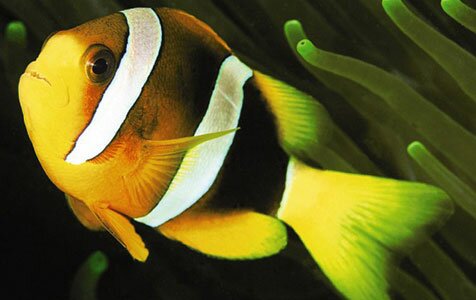Clark's Clownfish
From Microcosm Aquarium Explorer

Clark's Clownfish is larger and more robust than many of the anemonefishes. Scott W. Michael
Overview
Attractive and easy to feed and keep, this is one of the bigger, bolder clownfishes, also known as anemonefishes for their close association with sea anemones in the wild.
It is often mislabeled as the Sebae Clownfish, a smaller, less-robust species.
Family: Pomacentridae
Other common name(s):
- Clark's Anemonefish
- Yellowtail Clownfish
Native range:
Habitat: Reef, always in association with a sea anemone in the wild, but does not need a host to thrive in the aquarium.
Maximum length: 14 cm (6 in)
Minimum aquarium size: 114 L (30 gal)
Water: Marine 24 °C (75 °F) - 28 °C (82 °F)
General swimming level: Near substrate.
Feeding
Omnivore. Feed meaty and algae-based foods at least twice a day.
Aquarium Compatibility
This is a large, rough-mannered clownfish that does best with other pugnacious species (angelfishes, surgeonfishes, large wrasses). Smaller fishes may be attacked and injured—especially in smaller aquariums. They may also eat small shrimps or even feed them to their hosts. Keep only one per tank unless you can get them to pair up (add juveniles to the tank and one will usually become a functional female, while a less-dominant individual will develop male sex organs, and others, if any, act as passive standbys).
Breeding/Propagation
Demersal (on or near the bottom) spawners that tend and protect their broods.
Notes
This fish will swim about the tank between episodes of diving among the tentacles of its anemone host if one is present. Anemones can be very difficult to keep. The ideal choice is a captive-propagated Bubbletip Anemone (Entacmaea quadricolor). Also select tank-raised clownfishes whenever possible.








